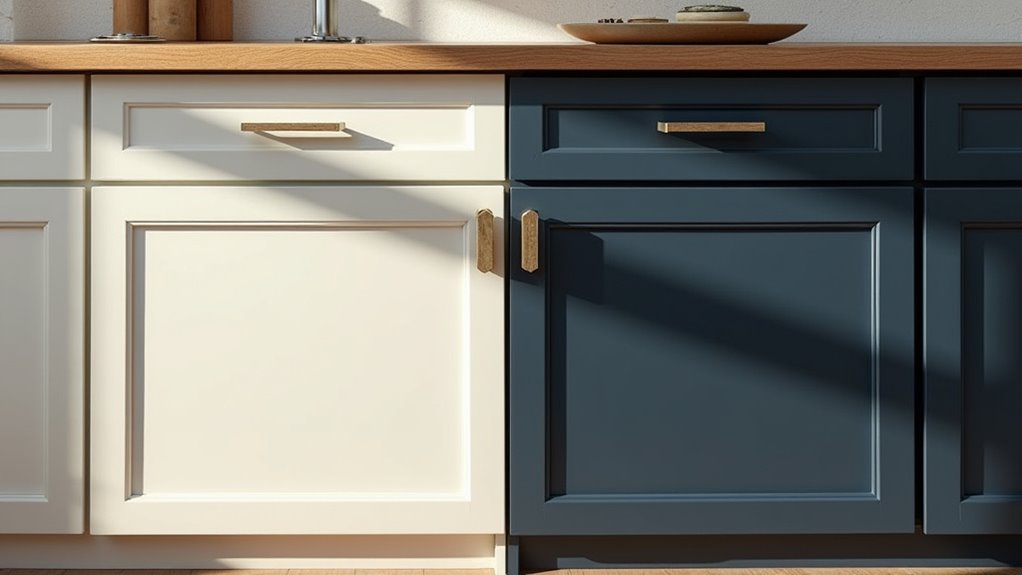When considering light versus dark kitchen cabinets, several key differences emerge. Light cabinets create a sense of space and cleanliness, reflecting natural light and enhancing versatility across design styles. In contrast, dark cabinets offer depth and warmth but may feel confining. Maintenance concerns also differ, as light cabinets show dirt more easily while dark options conceal imperfections. Moreover, light cabinets typically boost resale value. Exploring these distinctions reveals deeper insights into functionality and aesthetics.
Key Takeaways
- Light cabinets create an illusion of space and reflect natural light, enhancing the kitchen’s visual openness.
- Dark cabinets provide warmth and depth but may make the kitchen feel smaller and more confined.
- Maintenance differs; light cabinets require more cleaning due to their visibility of dirt, while dark cabinets hide stains more effectively.
- Light cabinets increase resale value as they appeal to a wider range of buyers and align with current design trends.
- The mood created by cabinet colors varies; light colors promote a bright atmosphere, while dark colors foster a cozy, intimate environment.
Visual Impact
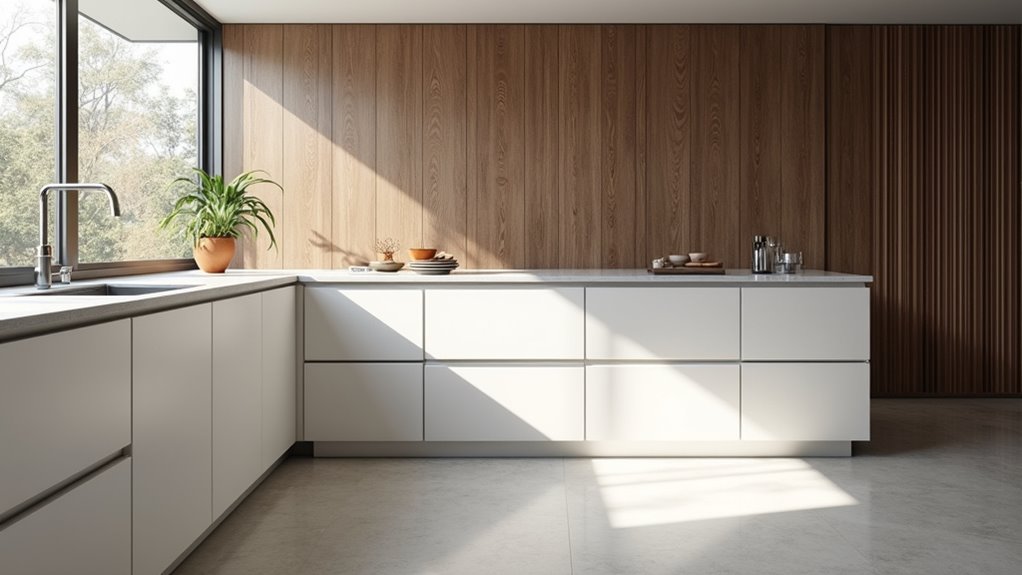
Although the choice between light and dark kitchen cabinets may seem purely aesthetic, their visual impact extends far beyond surface appearances.
Light cabinets reflect natural light, creating an optical illusion of space that enhances brightness and fosters an airy ambiance, particularly advantageous in compact kitchens. This effect aligns with color psychology, as lighter shades often evoke feelings of cleanliness and order. Additionally, the amount of light from windows significantly impacts the effectiveness of lighter colors, influencing the final decision. Moreover, light cabinets’ reflective quality enhances energy and vibrancy within the kitchen, making it feel more inviting.
Light cabinets amplify natural light, cultivating a sense of openness and cleanliness, especially beneficial in smaller kitchen spaces.
Conversely, dark cabinets can instill depth and warmth, producing a cozy atmosphere but may lead to visual confinement. Achieving visual harmony is vital, as balancing light and dark elements can optimize the kitchen’s aesthetic appeal, guiding the emotional experience of the space.
Thus, the decision profoundly influences both the kitchen’s functionality and its inviting presence.
Design Versatility
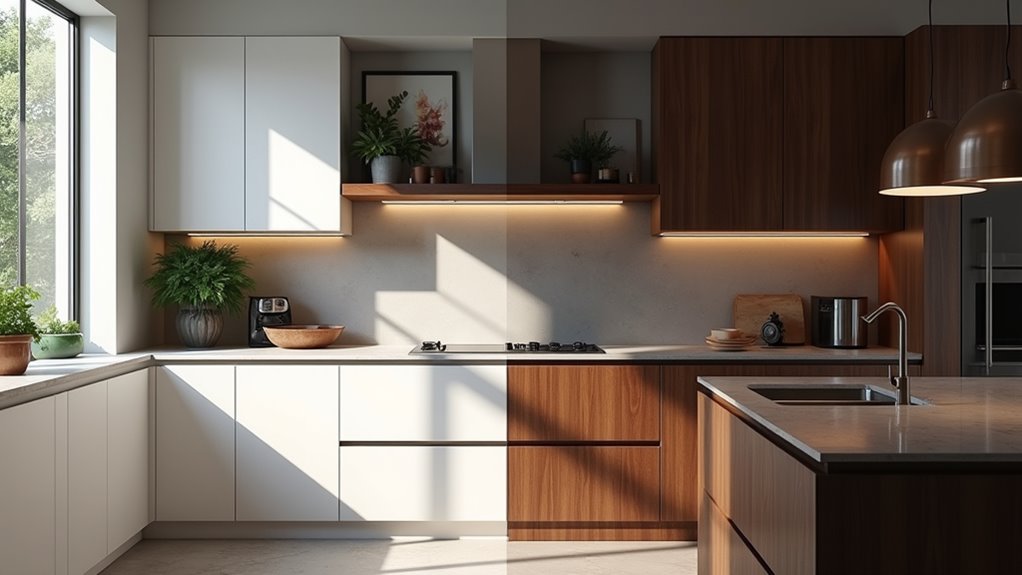
When considering design versatility, light kitchen cabinets stand out for their ability to seamlessly integrate into a wide array of styles and color schemes.
Their design flexibility allows them to adapt effortlessly to both modern and traditional aesthetics, serving as a neutral backdrop for various decor elements.
Light cabinets boast exceptional color compatibility, harmonizing beautifully with darker countertops or diverse materials like wood, stone, and metal.
This adaptability enhances a kitchen’s visual expansiveness by reflecting both natural and artificial light.
Furthermore, their timeless quality ensures they remain a relevant choice amidst ever-changing design trends.
Ultimately, the aesthetic balance created by light cabinets plays a key role in achieving a sophisticated and inviting kitchen environment.
Resale Value
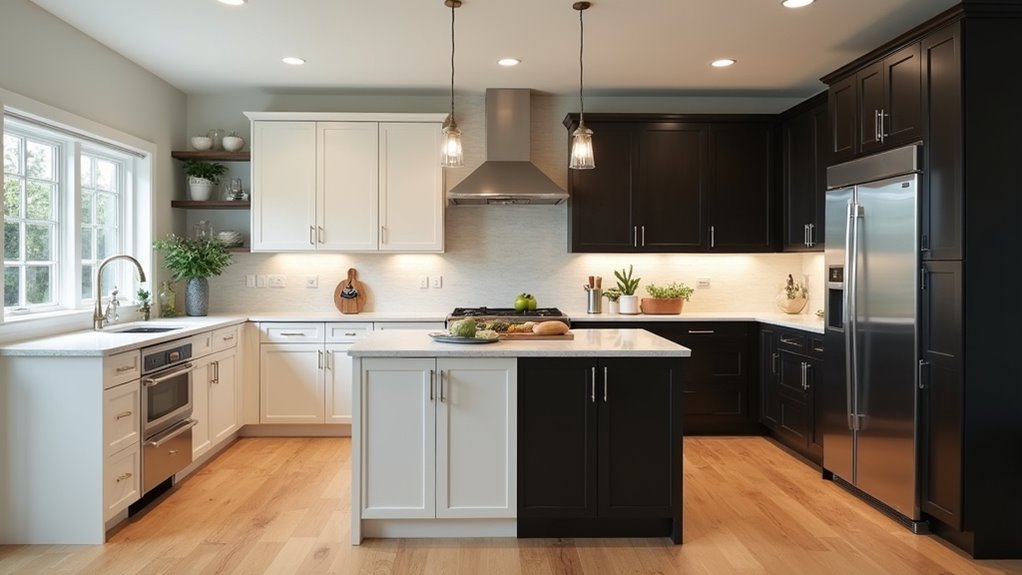
The choice of cabinet color holds significant weight in determining a home’s resale value, with light kitchen cabinets often seen as a strategic advantage. Their clean and spacious aesthetic appeals to a broad range of buyer demographics, making them a safer choice in diverse markets.
Light cabinets can create the illusion of larger spaces, particularly in compact kitchens, effectively enhancing buyer perception. Recent trends indicate a shift away from dark finishes, as they may detract from interest in a home, especially in smaller areas where they can feel oppressive. With modern buyers increasingly favoring airy and neutral tones, properties featuring light cabinets may enjoy higher market value and quicker sales, aligning with current market cycles. Moreover, the incorporation of layered lighting in kitchens with light cabinets can further enhance the overall appeal, making the space feel more inviting and spacious.
Maintenance
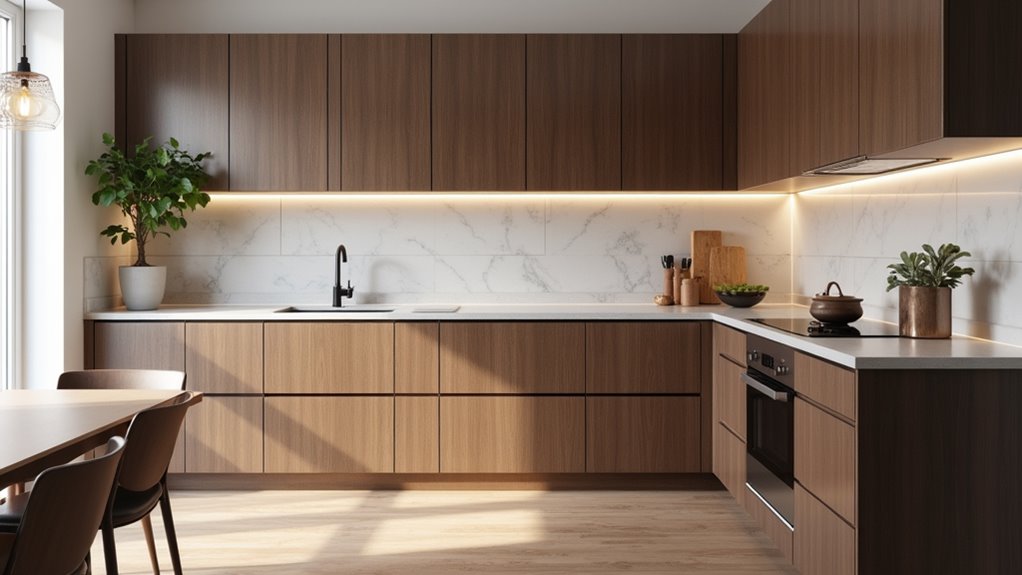
In the realm of kitchen design, maintenance emerges as a crucial factor that influences the longevity and aesthetic appeal of cabinetry.
Light cabinets, while visually appealing, exhibit higher dirt visibility and require more rigorous cleaning frequency to retain their pristine appearance. In contrast, dark cabinets offer a practical solution by concealing fingerprints and stains, making them a smarter choice for high-traffic kitchens.
- Light cabinets demand regular upkeep to prevent fading and maintain cleanliness.
- Dark cabinets’ forgiving nature against minor wear makes them family-friendly.
- Consider lifestyle and cooking habits to determine the best cabinet choice.
Additionally, both cabinetry types face challenges with color fading from sunlight exposure, underscoring the importance of high-quality materials.
Ultimately, the selection between light and dark cabinets should align with both aesthetic desires and practical maintenance concerns.
Mood and Atmosphere
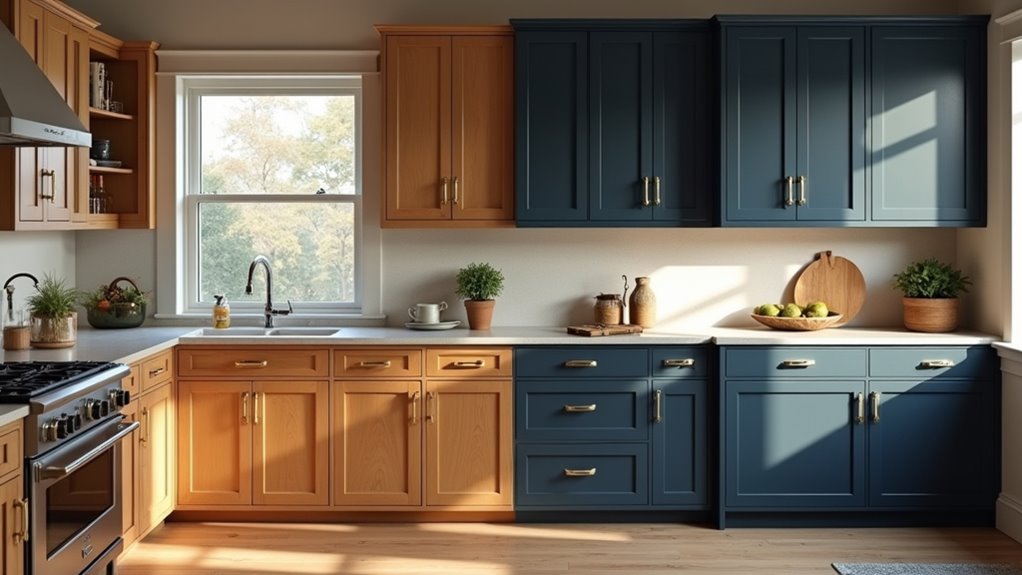
Although cabinet color may seem like a mere aesthetic choice, it profoundly influences the mood and atmosphere of a kitchen space.
Light kitchen cabinets evoke a bright, airy kitchen ambiance that enhances perceived spaciousness, fostering positivity and calmness. Their clean tones create a fresh environment conducive to creativity and uplifting interactions.
In contrast, dark cabinets generate richness and depth, imbuing the space with a sophisticated, intimate atmosphere that encourages focused gatherings. This color choice may elicit emotional responses, with darkness promoting a contemplative vibe while enhancing warmth in larger areas.
Ultimately, the selection of cabinet colors affects both the psychological and emotional response, dictating how a kitchen feels and functions in daily life.
Cost and Trends
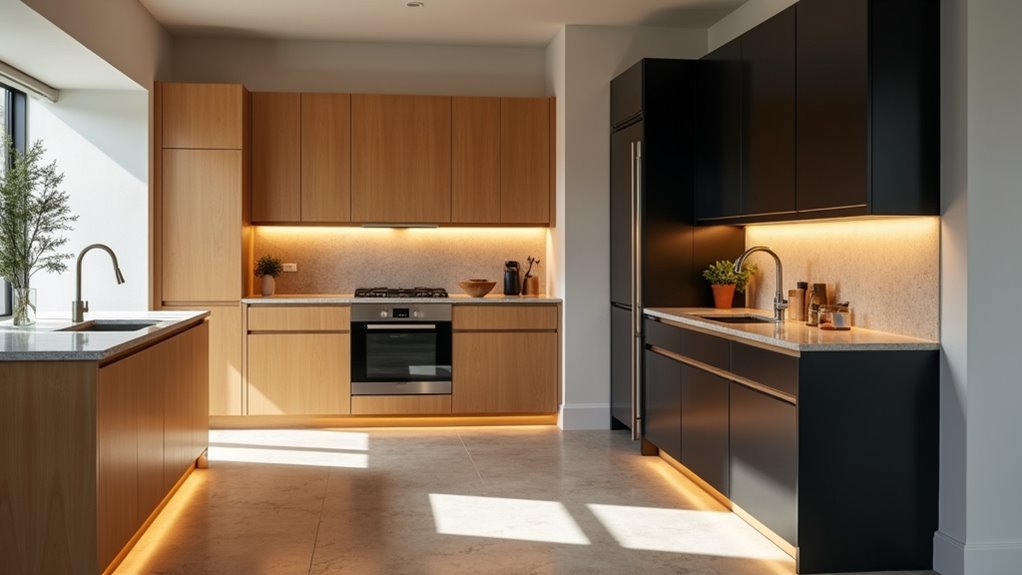
Choosing kitchen cabinet colors involves intricate considerations of cost and prevailing trends that can significantly influence both immediate expenses and long-term value.
In addition to aesthetic preferences, potential buyers often prioritize certain aspects when evaluating light versus dark cabinets.
- Light cabinets tend to be 10-15% costlier due to extra labor involved in painting.
- Dark stained options frequently offer lower maintenance demands, aligning with budget considerations.
- Current market trends favor light cabinetry for its expansive feel and increased resale value.
These selection criteria shed light on the financial implications of cabinetry choices, guiding homeowners through budget considerations while balancing style and investment potential in the competitive real estate market. Additionally, it is essential to consider the energy efficiency that different lighting options provide, which can impact overall kitchen costs.
Pros and Cons
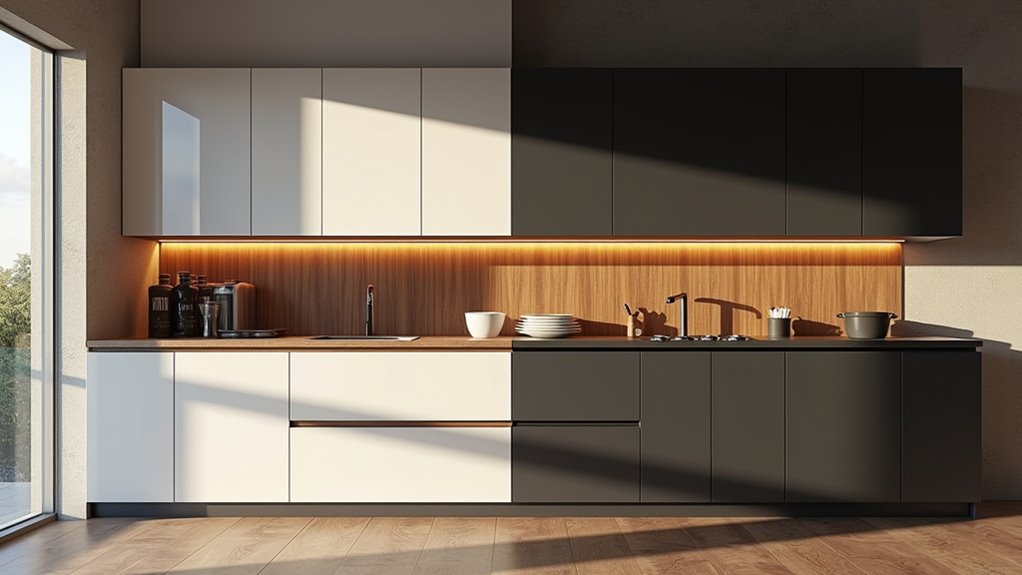
Aesthetics and functionality intertwine when considering the pros and cons of light versus dark kitchen cabinets, each option presenting distinct characteristics that cater to different preferences and needs.
Light cabinets enhance ambient lighting, reflecting natural and artificial light, which creates an open, airy atmosphere conducive to calmness, as supported by color psychology. However, they require frequent cleaning due to visibility of smudges.
Conversely, dark cabinets absorb light, evoking warmth and sophistication, making them suitable for larger spaces. Their ability to mask wear and tear is advantageous, yet they can create a cave-like feel in small kitchens.
Ultimately, the choice hinges on desired mood, maintenance considerations, and the balance between personal style and potential resale value.

